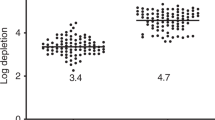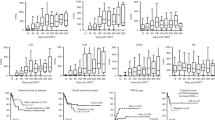Abstract
In a prospective study, we have investigated CD34+ selection of peripheral blood progenitor cells (PBPC) for autotransplantation in patients with lymphoma. Twenty-six consecutive patients (10 follicular lymphomas, seven mantle cell lymphomas, seven B-CLL, two immunocytomas) were mobilized using chemotherapy plus G-CSF. Sufficient numbers of PBPC could be collected from 24 patients and were immunoselected with the semiautomated Isolex 300 (n = 17) or the fully integrated Isolex 300i (n = 7) devices. The selection products were assayed by PCR amplification of clonal CDRIII or t(14;18) rearrangements for residual tumor cell content. Residual disease and long-term hematopoietic and immune recovery were studied by assessing the following parameters at 3, 6, and 12 months post-transplant: CDRIII or t(14;18) PCR, platelet count, lymphocyte subsets, serum IgG, serum IgA, and measles titer. With the Isolex 300 device 26% (10–65) of input CD34+ cells were recovered with a median purity of 89.2% (49.4–98.9) after CD34+ selection. The Isolex 300i device allowed significantly better recoveries (46% (22–86)) and purities of CD34+ cells (98.8% (92.2–99.2)). The overall purging efficacy was 3.2 (0.6–5.1) log. Twenty patients have been reinfused with CD34+ selected grafts after myeloablative preparation. Rapid engraftment occurred in all patients. With a median follow-up of 28 (19–42) months, 14 patients are alive without clinical or molecular evidence of disease recurrence, whereas five have relapsed and one additional patient shows persistent presence of the disease-specific molecular marker without clinical progression. Cellular and serological parameters of hematopoietic and immune functions were largely normal at 12 months post-transplant including the measles titer which was present in all patients. Kinetics of immunohematopoietic recovery were similar to those of 12 control patients who had received unmanipulated PBPC during the same time period except for the recovery of CD4+ CD45RA+ T cells which was significantly delayed in the CD34+ group. During the first year post-transplant, transient monoclonal or oligoclonal gammopathies were observed in seven of 16 study patients. We conclude that CD34+ selection with the Isolex system allows preparation of highly purified CD34+ fractions and effective tumor cell depletion. The CD34+ products can be reinfused safely after myeloablative treatment and result in sustained hematopoietic and immune recovery. The fact that all patients retained their specific measles immunity suggests that myeloablative treatment with reinfusion of highly purified CD34+ PBPC is not immunoablative.
This is a preview of subscription content, access via your institution
Access options
Subscribe to this journal
Receive 12 print issues and online access
$259.00 per year
only $21.58 per issue
Buy this article
- Purchase on Springer Link
- Instant access to full article PDF
Prices may be subject to local taxes which are calculated during checkout
Similar content being viewed by others
Author information
Authors and Affiliations
Rights and permissions
About this article
Cite this article
Dreger, P., Viehmann, K., von Neuhoff, N. et al. Autografting of highly purified peripheral blood progenitor cells following myeloablative therapy in patients with lymphoma: a prospective study of the long-term effects on tumor eradication, reconstitution of hematopoiesis and immune recovery. Bone Marrow Transplant 24, 153–161 (1999). https://doi.org/10.1038/sj.bmt.1701862
Received:
Accepted:
Published:
Issue Date:
DOI: https://doi.org/10.1038/sj.bmt.1701862
Keywords
This article is cited by
-
Importance of blood graft characteristics in auto-SCT: implications for optimizing mobilization regimens
Bone Marrow Transplantation (2011)
-
Red blood cell support and alloimmunization rate against erythrocyte antigens in patients undergoing hematopoietic stem cell transplantation
Bone Marrow Transplantation (2003)
-
Cellular and humoral immune reconstitution after autologous peripheral blood stem cell transplantation (PBSCT)
Annals of Hematology (2003)
-
High-dose therapy in patients with Hodgkin's disease: the use of selected CD34+ cells is as safe as unmanipulated peripheral blood progenitor cells
Bone Marrow Transplantation (2001)
-
CD34+-Selected Autologous Peripheral Blood Stem Cell Transplantation Conditioned With Total Body Irradiation for Malignant Lymphoma: Increased Risk of Infectious Complications
International Journal of Hematology (2001)



